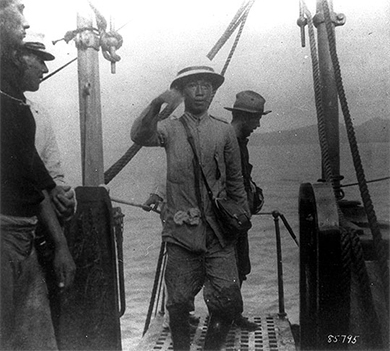| << Chapter < Page | Chapter >> Page > |
The newly formed American empire was not immediately secure, as Filipino rebels, led by Emilio Aguinaldo ( [link] ), fought back against American forces stationed there. The Filipinos’ war for independence lasted three years, with over four thousand American and twenty thousand Filipino combatant deaths; the civilian death toll is estimated as high as 250,000. Finally, in 1901, President McKinley appointed William Howard Taft as the civil governor of the Philippines in an effort to disengage the American military from direct confrontations with the Filipino people. Under Taft’s leadership, Americans built a new transportation infrastructure, hospitals, and schools, hoping to win over the local population. The rebels quickly lost influence, and Aguinaldo was captured by American forces and forced to swear allegiance to the United States. The Taft Commission, as it became known, continued to introduce reforms to modernize and improve daily life for the country despite pockets of resistance that continued to fight through the spring of 1902. Much of the commission’s rule centered on legislative reforms to local government structure and national agencies, with the commission offering appointments to resistance leaders in exchange for their support. The Philippines continued under American rule until they became self-governing in 1946.

After the conclusion of the Spanish-American War and the successful passage of the peace treaty with Spain, the United States continued to acquire other territories. Seeking an expanded international presence, as well as control of maritime routes and naval stations, the United States grew to include Hawaii, which was granted territorial status in 1900, and Alaska, which, although purchased from Russia decades earlier, only became a recognized territory in 1912. In both cases, their status as territories granted U.S. citizenship to their residents. The Foraker Act of 1900 established Puerto Rico as an American territory with its own civil government. It was not until 1917 that Puerto Ricans were granted American citizenship. Guam and Samoa, which had been taken as part of the war, remained under the control of the U.S. Navy. Cuba, which after the war was technically a free country, adopted a constitution based on the U.S. Constitution. While the Teller Amendment had prohibited the United States from annexing the country, a subsequent amendment, the Platt Amendment, secured the right of the United States to interfere in Cuban affairs if threats to a stable government emerged. The Platt Amendment also guaranteed the United States its own naval and coaling station on the island’s southern Guantanamo Bay and prohibited Cuba from making treaties with other countries that might eventually threaten their independence. While Cuba remained an independent nation on paper, in all practicality the United States governed Cuba’s foreign policy and economic agreements.
Explore the resources at U.S. History Scene to better understand the long and involved history of Hawaii with respect to its intersection with the United States.
In the wake of the Civil War, American economic growth combined with the efforts of Evangelist missionaries to push for greater international influence and overseas presence. By confronting Spain over its imperial rule in Cuba, the United States took control of valuable territories in Central America and the Pacific. For the United States, the first step toward becoming an empire was a decisive military one. By engaging with Spain, the United States was able to gain valuable territories in Latin America and Asia, as well as send a message to other global powers. The untested U.S. Navy proved superior to the Spanish fleet, and the military strategists who planned the war in the broader context of empire caught the Spanish by surprise. The annexation of the former Spanish colonies of Guam, Puerto Rico, and the Philippines, combined with the acquisition of Hawaii, Samoa, and Wake Island, positioned the United States as the predominant world power in the South Pacific and the Caribbean. While some prominent figures in the United States vehemently disagreed with the idea of American empire building, their concerns were overruled by an American public—and a government—that understood American power overseas as a form of prestige, prosperity, and progress.

Notification Switch
Would you like to follow the 'U.s. history' conversation and receive update notifications?